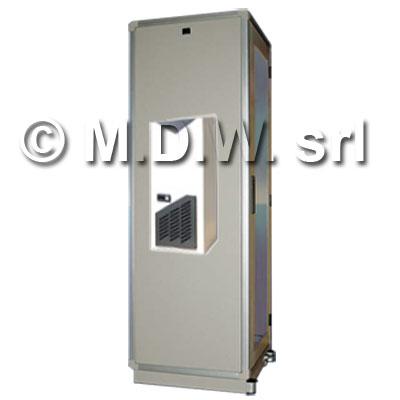As is known, thermal stress is one of the main causes of malfunctions and breakdowns of computer and electronic equipment, for these reasons it is essential to foresee every possible criticality and implement adequate control and air conditioning systems.
The tools and air conditioning modes of rack cabinets and industrial electrical panels are varied and depend on several factors:
Air extraction: fan kit and grilles for installation on the ceiling or on walls, the cooling of the inside of the cabinet is obtained by hot air extraction and fresh air entry from the outside. This system works at an environmental level in the sense that it is assumed that the environment that houses the cabinet is suitably cooled.
Air conditioning: Industrial air conditioners for cooling and dehumidifying the air inside the cabinet. Unlike extraction cooling systems with fans, air conditioning cooling acts at the cabinet level for greater precision and control.
Heating: anti-condensation heaters with PTC, specially designed to prevent malfunctions due to condensation and to prevent any decrease in temperature. An aluminum cover is added to the heater whose function is to insulate the hot part, avoiding burns on contact and at the same time facilitating cleaning operations. The same cover, combined with the radiator, facilitates the suction of heat, acting in the typical manner of a fireplace.
The air conditioning of a confined environment consists of the set of operations carried out to allow predetermined thermo-hygrometric conditions for the use of that environment for given purposes. The air conditioning of a room includes, in relation to the characteristics of the external climate and internal activity (with relative production of endogenous heat), the following functions: heating or cooling, ventilation with or without air filtration, humidification or dehumidification.
When you have to air condition a rack cabinet or an electrical panel, the first decision to be made concerns the environmental level of air conditioning: single cabinet or entire room.
In some cases the choice is obligatory, for example a cabinet positioned in a shed or in another large space at an uncontrollable temperature will necessarily be air-conditioned at the level of a single cabinet, while if placed in an air-conditioned CED room it may not need additional control systems.

The air conditioning of the single cabinet can be achieved through the application of fans, heaters, air conditioners, dehumidifiers, thermostats.
ceiling fans: these fans generally operate in extraction by exploiting and increasing the natural movement of hot air from bottom to top.
wall fans on doors and sides: also in this case the fans positioned in the upper part of the cabinet will work in extraction exploiting and increasing the natural movement of hot air from bottom to top while any fans positioned in the lower part of the cabinet will work in suction.
industrial air conditioners: generally applied on the side of the cabinet operate in a closed circuit by sucking hot air from inside the cabinet and blowing fresh air into it. The air conditioner works only for closed and appropriately sized spaces for which the cabinet must have an IP55 degree of protection and the air conditioner will be sized according to the internal dimensions of the cabinet and the number and characteristics of the active objects inside the rack. The air conditioner, in addition to keeping the internal temperature of the rack controlled, dehumidifies the environment, extending the average life of the equipment stored in the cabinet.
anti-condensation heaters: mainly used in the installation of rack cabinets and electrical panels outdoors or in unheated rooms allow to keep the temperature of the racks within certain tolerance limits and guarantee a good anti-condensation effect (lethal for all electrical devices).
When the rack cabinet is positioned inside a CED room, the air conditioning is generally managed at the upper level, of the entire room, so the cabinet has characteristics diametrically opposed to those seen for the air-conditioned cabinet. The degree of protection is very low, generally IP20 or even absent when choosing to adopt open or open frame cabinets (19" rack frames feel sides and doors).
horizontal ventilation: when the rack is placed inside an air-conditioned room, the air flow can be conveyed inside the cabinet by means of fans placed on one cabinet door while on the other door there will be adequate air access slots or a more common grill. In this case the air flow will pass through the cabinet horizontally cooling all the devices in the same way regardless of the vertical position they occupy inside the rack. Since the natural flow of hot air tends to go from the bottom upwards, and in order to prevent the extracted hot air from immediately entering the rack, there is a tendency to divide the internal spaces of the cabinet into sectors at different heights so that it is physically impossible for the air to "stagnate" inside.
See also
Electrical panels
subrack.eu + armadi-rack.it© are run by M.D.W. srl - About Us
M.D.W. srl Chamber of Commerce, Bologna
REA n° 465866
PI/CF 02766841205
Legal office:Piazza Minghetti, 4/D
Bologna 40124 BO, Italy
Operating office:Via Edmondo De Amicis 7
Casalecchio di Reno 40033 BO, Italy